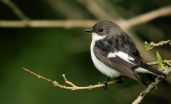(Press-News.org) Just how new species are established is still one of the most central questions in biology. In an article in the leading scientific journal Nature, researchers at Uppsala University in Sweden describe how they mapped the genomes of the European pied flycatcher and the collared flycatcher and found that it is disparate chromosome structures rather than separate adaptations in individual genes that underlies the separation of the species.
"We were surprised that such a large part of the genome was nearly identical in the two species," says Hans Ellegren, professor of evolutionary biology and director of the research team behind the new findings.
The big question in species-differentiation research today involves the genetic background of how two evolutionary lines gradually come to diverge from each other and ultimately cannot produce fertile young. Horses and donkeys, for instance, can crossbreed and produce mules and hinnies, but something in the genome of the latter makes them infertile. There must therefore be DNA sequences from diverging evolutionary lines that are not compatible.
Researchers at the Evolutionary Biology Centre, Uppsala University, are now presenting the genome sequence for the two flycatchers, which are the first organisms apart from so-called model organisms, to have their genome sequenced. They are also the first DNA sequences for a vertebrate to have been determined entirely by Swedish researchers and at a Swedish laboratory.
The Uppsala scientists have charted the genome of the flycatchers and then sequenced the entire genome of some ten individuals of European pied flycatcher and the collared flycatcher respectively. The two species occur together on the Baltic islands of Öland and Gotland, where they sometimes hybridize, that is, mate with each other.
The scientists have now managed to identify the regions in the respective flycatchers' genomes that are most clearly different. It turns out that it is a matter of one or a few regions per chromosome, and these regions coincide with the chromosome parts that are involved in meiosis and the production of gender cells (centromeres). This indicates that what underlies the separation of the species it is the disparate chromosome structures rather than different adaptations in individual genes.
"There is good reason to believe that this observation is highly generalizable and that it explains species differentiation across organism groups," says Hans Ellegren.
The European pied flycatcher, and later its close relative the collared flycatcher, have long been an important research organism for scientists at many universities. Their nesting (and thereby reproductive success) is rather easy to observe, as they readily inhabit deployed birdhouses. Over the years Uppsala research has laid a foundation for understanding many general aspects of ecology and evolution, with multiple doctoral dissertations and acclaimed research reports.
INFORMATION:
For more information please contact Hans Ellegren, mobile: +46 (0)70-4250637, e-mail: Hans.Ellegren@ebc.uu.se
Ellegren H, et al. (2012) The genomic landscape of species divergence in Ficedula flycatchers, Nature, DOI: 10.1038/nature11584
Flycatchers' genomes explain how 1 species became 2
2012-10-25
ELSE PRESS RELEASES FROM THIS DATE:
Parkinson's breakthough could slow disease progression
2012-10-25
CHICAGO --- In an early-stage breakthrough, a team of Northwestern University scientists has developed a new family of compounds that could slow the progression of Parkinson's disease.
Parkinson's, the second most common neurodegenerative disease, is caused by the death of dopamine neurons, resulting in tremors, rigidity and difficulty moving. Current treatments target the symptoms but do not slow the progression of the disease.
The new compounds were developed by Richard B. Silverman, the John Evans Professor of Chemistry at the Weinberg College of Arts and Sciences ...
Survival of the affordable care act assessed in new commentaries
2012-10-25
(Garrison, NY) As the presidential candidates clash over the fate of the Affordable Care Act, a set of seven essays by leading legal experts, economists, and scholars examines the implications of the Supreme Court's decision on the ACA and makes it clear that there is no consensus about what is economically or morally just when it comes to health care coverage in this country. The essays appear in the Hastings Center Report.
While the essays provide a range of perspectives, a few common themes emerge. Foremost among them is that the individual mandate may not work as ...
Gene linked to inflammation in the aorta may contribute to abdominal aortic aneurysm
2012-10-25
A gene known to be involved in cancer and cardiovascular development may be the cause of inflammation in the most common form of aortic aneurysm and may be a key to treatment, according to research from Nationwide Children's Hospital. The study, appearing online in Arteriosclerosis, Thrombosis, and Vascular Biology on October 18, 2012, is the first to show that Notch 1 signaling is activated in abdominal aortic aneurysmal tissue in mice and humans.
The aorta is the largest blood vessel in the body. Abdominal aortic aneurysm (AAA) occurs when the weakened aortic wall dilates ...
Results of the ETAP trial presented at TCT 2012
2012-10-25
MIAMI, FL – OCTOBER 24 , 2012 – A study found that a nitinol stent performed better than balloon angioplasty alone in treating blockages of the popliteal artery, which runs through the leg behind the knee. Results of the ETAP trial were presented today at the 24th annual Transcatheter Cardiovascular Therapeutics (TCT) scientific symposium. Sponsored by the Cardiovascular Research Foundation (CRF), TCT is the world's premier educational meeting specializing in interventional cardiovascular medicine.
Due to its location behind the mobile knee joint, it is controversial ...
Brain waves reveal video game aptitude
2012-10-25
CHAMPAIGN, Ill. — Scientists report that they can predict who will improve most on an unfamiliar video game by looking at their brain waves.
They describe their findings in a paper in the journal Psychophysiology.
The researchers used electroencephalography (EEG) to peek at electrical activity in the brains of 39 study subjects before they trained on Space Fortress, a video game developed for cognitive research. The subjects whose brain waves oscillated most powerfully in the alpha spectrum (about 10 times per second, or 10 hertz) when measured at the front of the head ...
Results of the TRILOGY ACS Angiographic Cohort presented at TCT 2012
2012-10-25
MIAMI, FL – OCTOBER 24, 2012 – A study has found that the anti-clotting medication prasugrel reduced cardiovascular events among patients who present with an acute coronary syndrome and are managed medically after an angiogram is performed to determine coronary anatomy. Results of the TRILOGY ACS trial, Angiographic Cohort were presented today at the 24th annual Transcatheter Cardiovascular Therapeutics (TCT) scientific symposium. Sponsored by the Cardiovascular Research Foundation (CRF), TCT is the world's premier educational meeting specializing in interventional cardiovascular ...
Large-scale production of biofuels made from algae poses sustainability concerns
2012-10-25
WASHINGTON — Scaling up the production of biofuels made from algae to meet at least 5 percent -- approximately 39 billion liters -- of U.S. transportation fuel needs would place unsustainable demands on energy, water, and nutrients, says a new report from the National Research Council. However, these concerns are not a definitive barrier for future production, and innovations that would require research and development could help realize algal biofuels' full potential.
Biofuels derived from algae and cyanobacteria are possible alternatives to petroleum-based fuels and ...
A sense of control, even if illusory, eliminates emotion-driven distortions of time
2012-10-25
CHAMPAIGN, Ill. — We humans have a fairly erratic sense of time. We tend to misjudge the duration of events, particularly when they are emotional in nature. Disturbingly negative experiences, for example, seem to last much longer than they actually do. And highly positive experiences seem to pass more quickly than negative ones.
Researchers say they have found a way to lessen these emotion-driven time distortions. Having a sense of control over events reduces the influence of emotions on time perception, the researchers report. This is true even for highly reactive emotional ...
FFR-guided PCI shows cost-effectiveness when compared to medical therapy for stable CAD
2012-10-25
MIAMI, FL – OCTOBER 24, 2012 –A strategy of up-front percutaneous coronary intervention (PCI) for lesions confirmed to be obstructive by fractional flow reserve (FFR) was shown to be cost-effective in terms of quality-adjusted life years when compared to medical therapy alone. Results of the Cost-Effectiveness sub study of the FAME 2 trial were presented today at the 24th annual Transcatheter Cardiovascular Therapeutics (TCT) scientific symposium. Sponsored by the Cardiovascular Research Foundation (CRF), TCT is the world's premier educational meeting specializing in interventional ...
Study confirms benefits of transcatheter aortic valve replacement over 3 years
2012-10-25
MIAMI, FL – OCTOBER 24, 2012 – A study found that transcatheter aortic valve replacement (TAVR) yielded lower mortality rates after three years compared with medical therapy in patients deemed to be ineligible for conventional aortic valve surgery. Results of the PARTNER Cohort B trial were presented today at the 24th annual Transcatheter Cardiovascular Therapeutics (TCT) scientific symposium. Sponsored by the Cardiovascular Research Foundation (CRF), TCT is the world's premier educational meeting specializing in interventional cardiovascular medicine.
TAVR is the recommended ...


